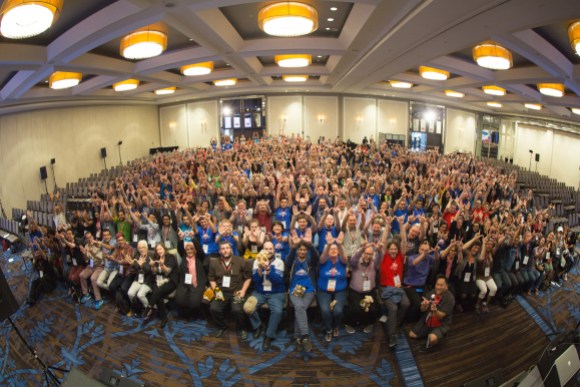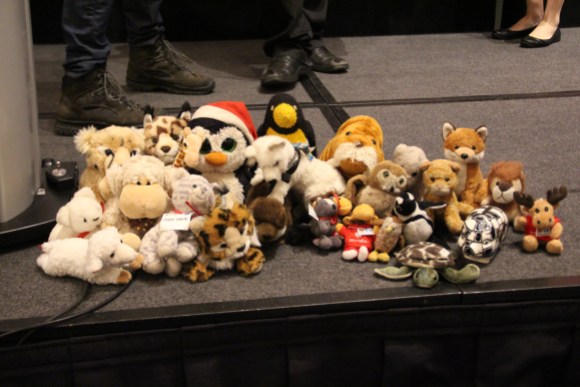
Perhaps the best phase to describe Wikimania 2017 is “brain-expanding and a little overwhelming.” Over the course of the three days that compose the main program of the Wikimedia community’s annual conference, there were five keynote sessions, over a hundred community-submitted talks, meetups and lightning talks. The conference was preceded by two days of a hackathon, the Wikimedia Conference of North America, and other workshops.
Over 900 people attended Wikimania 2017 in person, but we also wanted to ensure that the conversations and ideas that surfaced at Wikimania would be accessible well beyond the conference. Below, we detail how we approached remote participation so that people could follow along with the conference either in real-time or find archival material at some point in the future. We also detail what we learned and might change or improve for future events. Please feel free to borrow any of this material for conferences you are attending or leading in the future.
Note-taking
A number of Wiki-related conferences have had robust note-taking programs, and we looked at both the 2017 Wikimedia Developer Summit and Wikimania 2016 in Esino Lario for guidance on how to construct a note-taking program that would be easy for both presenters and attendees to use. We liked how the Developer Summit asked notetakers to take notes using an Etherpad template, and to follow notetaking instructions outlined on the Session Guidelines page; we also appreciated that the Developer Summit collected all session notes on one page to make it easy for remote viewers to scroll and find notes and slides.
We borrowed this approach for Wikimania 2017. Participants and presenters were asked to copy an Etherpad template for their sessions, and to contribute their notes, slides, and any documentation they had on a single wiki page to make it easy for remote participants and people attending simultaneous sessions to both follow along in real-time and access material in the future. We also added categories and themes to this page so that readers could easily sort the sessions by topic. Instructions on how to take good notes were added to the speaker’s page.
Prior to the conference, we emailed the Wikimedia-l and Wikimania-l mailing lists with how to follow along with sessions in real time. Each day at the conference, participants were reminded to take notes in their sessions for archival purposes and to help remote attendees. We also emailed session leaders after the conference, asking them to share their material on the All Session Notes page.
Possible improvements and notes
- A number of attendees suggested that the note-taking templates for each session should be created ahead of time, making it easier for attendees to jump in and get started taking notes.
- Not every session designated a notetaker.
- We received a number of requests to have certain sessions transcribed in real time, both to help remote participants and for accessibility and translation purposes. Though expensive, real-time transcription does help remote participants more fully experience a conference.
Live streaming
We initially scoped out livestreaming a number of simultaneous sessions throughout the conference, but realized quickly that we didn’t have the equipment or staffing to do so. Instead, we livestreamed four keynotes on both YouTube and Facebook Live and recorded and uploaded all talks taking place in Ballroom West to both YouTube and Wikimedia Commons. It was not possible to move the audio and video equipment between rooms.

Metrics
This was our first time livestreaming to the Wikipedia Facebook account. On average, these Facebook Live streams doubled the in-person attendance figures at Wikimania, broadening the reach of the conference and ensuring that remote participants could access the keynote sessions. About 3 percent of Facebook users who saw the streams provided negative feedback by hiding the post or unliking the page.
One important note: two of the keynotes were presented, in parts, in French. The first keynote—“Community and information in a partisan world”—started in French, and was served to the entire Facebook Wikipedia audience. Traffic to the video dropped almost immediately—most non-French-speaking viewers left the livestream after 15 seconds—and viewers complained about the lack of translation available. The second keynote “Libraries, Archives and sharing knowledge” took place entirely in French, and was served only to Facebook users who identified themselves as French speakers. The dropoff of viewers was much less severe. Top locations viewing this video were in Tunisia, California, and France. (Quebec came in fourth place.) This indicated that talks in multiple languages or in a language other than the dominant language on a Facebook page should be served to a targeted audience, or translated in real-time.
Over 48,000 Facebook users watched the Wikimedia 2030 video announced during Katherine and Christophe’s keynote. (This is the only video we ran during Wikimania that wasn’t a keynote.)
Possible improvements and notes
- The initial livestreamed opening talk was in both French and English. We didn’t specify language on the video streams, and a number of non-French-speaking viewers dropped off. It is possible to specify “language” and “country” on video streams, and that might have improved audience satisfaction. Viewers get frustrated and leave when they can’t understand what speakers are saying. Descriptions for these videos should match the language in which they’re spoken.
- We livestreamed and/or recorded all talks taking place in a single room without determining whether these were the most important talks to record. For future years, if video and audio equipment is limited, we recommend determining which talks should be recorded and then placing them in a room with recording equipment. (In other words, put all recordable sessions in the same room or rooms.) We recommend that the Program Committee make these decisions.
- We didn’t have enough staff to moderate YouTube comments and ended up turning them off. They were off-topic, and didn’t add to the conversation. We’d like to experiment with ways that remote participants can ask questions and have a dialogue.
- A good, constructive conversation took place on Wikimedia-l about the centralnotice banners that were used to let people know about the video streams. This was a relatively last minute decision, and we agree that the dialogue about when and how to use centralnotice should begin earlier. We recommend that these conversations take place publicly and earlier for future conferences.
- Having the keynote speakers’ slides and speeches in advance would have allowed us to simultaneously provide context or additional information to viewers with limited bandwidth who couldn’t stream video or to people with hearing difficulties.
- Facebook Live videos should start as close to the speaking time as possible. We recommend scheduling a live stream and sending a reminder notification to page followers rather than starting a video shortly before an event starts.
- For streaming videos, until the livestream starts, overlaid images should have the speaker name, time of starting speech, title so viewers know exactly what’s about to take place.
- Should we stream on Wikipedia’s Facebook page or would this be more appropriate for a Wikimania Facebook page?
Social media
We followed the hashtags #wikimania, #wikimania17, and #wikimania2017 and retweeted pertinent tweets into the @wikimania, @wikimedia, @wikipedia, and @mediawiki Twitter accounts. We also alerted various Facebook groups and the main Wikipedia Facebook page about sessions that would be livestreamed in advance. Lastly, we put a January 2017 profile of Felix Nartey on social media simultaneously with Jimmy Wales’ announcement that he was named the Wikimedian of the Year. During the conference, @Wikimania earned 73,800K impressions total, with 1.3% of those users (about 959) engaging with tweets through clicks, likes, retweets, and replies.
Possible improvements and notes
- A number of people asked what the canonical hashtag was to follow the event. We recommend that event organizers pick one hashtag and make it clear to attendees—so that audiences don’t have to follow multiple hashtags.
- Social media coordination should begin at least 2–3 months before the event takes place, especially when translation is required.
- Anything that can be planned ahead of time should be. If we have quotes from previous interviews or speeches from keynotes in advance, social material can be designed around that.
Melody Kramer, Senior Audience Development Manager, Communications
Wikimedia Foundation
Thank you to the Foundation’s Aubrie Johnson for compiling many of the metrics listed above for livestreaming and social media.

Can you help us translate this article?
In order for this article to reach as many people as possible we would like your help. Can you translate this article to get the message out?
Start translation